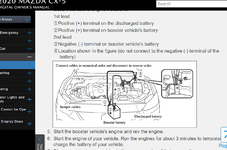If you run the battery down more than likely the rear hatch will no longer open.
System will go into a fail-safe model.
To reset disconnect the battery for 10 minutes, hopefully you will have a battery tender to save your favorites/settings/etc.
Not sure this is mentioned in the manual.
System will go into a fail-safe model.
To reset disconnect the battery for 10 minutes, hopefully you will have a battery tender to save your favorites/settings/etc.
Not sure this is mentioned in the manual.


